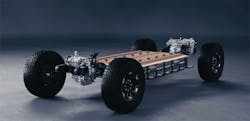New Li-Ion Battery Research Offers Greater Power
This article appeared in Machine Design and has been published here with permission.
What you'll learn:
- Researchers have developed a method for extending the life of Li-ion batteries.
- When an intermediate phase is formed in the phase transition during the charging and discharging, greater power can be produced.
The driving range of an electric vehicle (EV) depends on its battery performance.
Faster charging and longer-lasting battery material for electric cars depend on batteries of various design. However, lithium-ion batteries dominate battery types used in EVs, providing the impetus for further research into faster charging and longer-lasting battery material.
Parameters such as lifespan, safety, cost performance, energy and power or loading capability are significant in considering suitable battery types in EV applications. General Motors’ EV platform, for example, is powered by an Ultium battery system, a lithium-ion-based cell offering capacities that range from 50 to 200 kWh, and could enable a range up to 400 miles on a full charge. The automaker’s first full-electric vehicle, the 2022 GMC HUMMER EV, will get its energy from Ultium batteries.
One area in Li-ion battery research that remains unresolved is how greater power can be produced by significantly reducing the charging and discharging time without reducing the particle size of electrode materials. The problem with reducing the particle size is that it decreases the volumetric energy density of the batteries.
Materials science researchers at Pohang University of Science & Technology (POSTECH) in Korea have developed a method for extending the life of Li-ion batteries. Reporting in Energy & Environmental Science, the researchers noted that when an intermediate phase is formed in the phase transition during the charging and discharging, greater power can be produced without losing high energy density or reducing the particle size through rapid charging and discharging.
The researchers noted that “phase transition” occurs when lithium is inserted and dislodged during charging and discharging and the existing phase of the substance transforms into a new phase.
The buffering intermediate phase makes all the difference, as it supports the development of a longer-lasting Li-ion battery. This method can help create and grow a new phase within the particle, which the researchers noted improves the speed of insertion and removal of lithium in the particle. In turn, the intermediate phase formation can dramatically increase the charging and discharging speed of the cell by creating a homogenous electrochemical reaction in the electrode.
The Li-ion battery electrodes synthesized by the research team charged up to 90% in 6 min. and discharged 54% in 18 sec. These results, they said, are a promising sign for developing high-power Li-ion batteries.
“This research has laid the foundation for developing Li-ion batteries that can achieve quick charging and discharging speed, high energy density and prolonged performance,” said Professor Byoungwoo Kang, a co-author of the paper.
The research was carried out by a team led by Kang and Dr. Minkyung Kim of the Department of Materials Science and Engineering at POSTECH, as well as one led by Professor Won-Sub Yoon of the Department of Energy Science at Sungkyunkwan University in Korea.
About the Author

Rehana Begg
Editor-in-Chief, Machine Design
As Machine Design’s content lead, Rehana Begg is tasked with elevating the voice of the design and multi-disciplinary engineer in the face of digital transformation and engineering innovation. Begg has more than 24 years of editorial experience and has spent the past decade in the trenches of industrial manufacturing, focusing on new technologies, manufacturing innovation and business.
Her B2B career has taken her from corporate boardrooms to plant floors and underground mining stopes, covering everything from automation & IIoT, robotics, mechanical design and additive manufacturing to plant operations, maintenance, reliability and continuous improvement.
Begg holds an MBA, a Master of Journalism degree, and a BA (Hons.) in Political Science. She is committed to lifelong learning and feeds her passion for innovation in publishing, transparent science and clear communication by attending relevant conferences and seminars/workshops.


